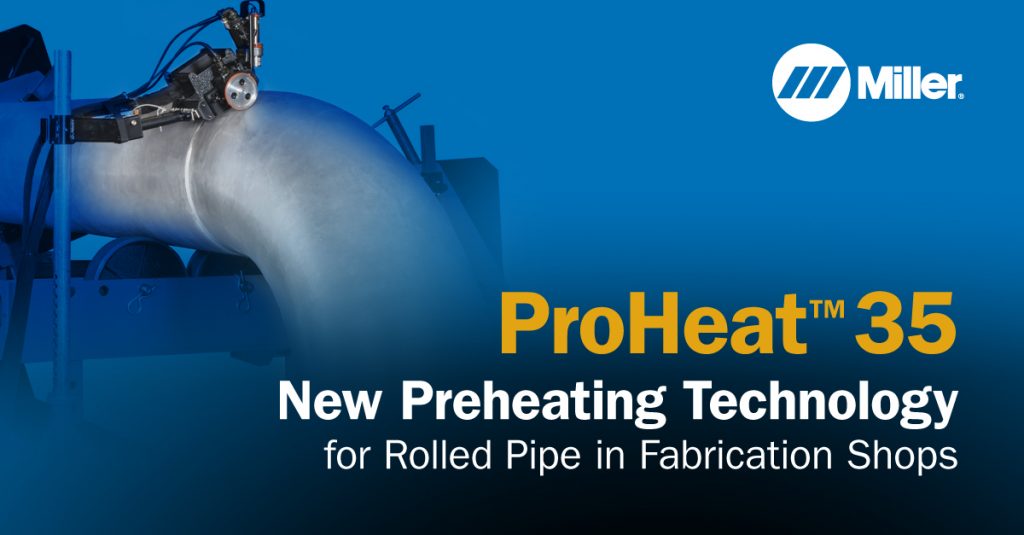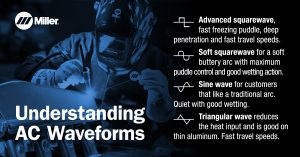Preheating pipe is also a common practice that helps reduce the potential for a failed weld. It’s necessary for meeting code or quality requirements when the pipe is chrome alloy, more than 2.5 cm thick or stored in environments colder than 10℃.
There are numerous methods for preheating, each with benefits and drawbacks. However, rolling pipe while welding limits the options for successfully preheating, maintaining preheat temperatures and adhering to interpass temperatures. This article looks at a new technology — rolling induction heating — available for preheating rolled pipe in a shop environment. It enables the benefits of rolled pipe welding while also addressing some of the concerns associated with other popular heating methods, such as open flame and resistance heating.
How does induction heating compare?
Induction heating has been around for decades, but in the past it wasn’t well-suited for roll-welded applications due to the heating cables that had to be wrapped around the pipe. However, a new rolling induction technology exclusive to Miller® has an inductor that sits on the pipe and does not interfere with the rotation of the pipe. The inductor operates on a standard pipe stand and connects to a ProHeat™ 35 power source.
As with standard induction heating, the new technology for roll-welded applications uses a noncontact method to quickly heat conductive metals by inducing current into the part. Induction does not rely on a heating element or flame to transfer heat. Instead, an alternating current passes through the device, creating a magnetic field around it. As the magnetic field passes through the conductive workpiece, it creates eddy currents within the part. The resistance of the metal fights against the flow of the eddy currents, generating heat in the part. The part becomes its own heating element, heating from within, which makes induction very efficient since little heat is lost in the process.
As with standard induction heating, the new technology for roll-welded applications uses a noncontact method to quickly heat conductive metals by inducing current into the part. Induction does not rely on a heating element or flame to transfer heat. Instead, an alternating current passes through the device, creating a magnetic field around it. As the magnetic field passes through the conductive workpiece, it creates eddy currents within the part. The resistance of the metal fights against the flow of the eddy currents, generating heat in the part. The part becomes its own heating element, heating from within, which makes induction very efficient since little heat is lost in the process.
The technology helps address many of the safety, efficiency and quality concerns associated with some other popular methods for preheating pipe.
Many fabrication shops use an open flame from a torch simply because it is an easy method, in part due to its quick and simple setup. Also, many of these shops already have a torch on hand, so welding operators are familiar with the equipment, and the initial investment cost is lower.
However, preheating with open flame can be a rather inefficient method compared to rolling induction heating because much of the heat is lost into the surrounding air, and it tends to be more expensive in the long run due to the use of consumables. It also poses safety hazards and creates fumes. Specifically, there is increased burn potential with this method; it requires storing explosive gases, usually propane or propylene; and workers are consistently exposed to carbon monoxide fumes. Inconsistent heating is another issue, since the area directly below the flame gets hotter than the rest of the part.
Resistance heating, which uses ceramic heating pads wrapped around the part, is an electric form of preheating that some fabrication shops may rely on. The ceramic pads used in resistance heating often heat up to over 1000℃, so they must be allowed to cool down before removal, to avoid burn potential. This required cool-down, plus the longer setup process, adds time to the preheating stage. Also, the cables and wires required for resistance heating make this method less suited for roll-welded applications.
Resistance is typically done on a contract basis, meaning fabrication shops pay heating contractors to supply the equipment and the people to perform the job. This contract means no equipment maintenance costs for the shop, but can result in added time and costs in the long run to bring in an outside contractor for the work every time. The setup and cool-down processes used with resistance heating also mean the contractor may be idle while waiting for the next part to be ready, which could add to costs.
Productivity and ease of use
Rolling induction technology is designed to be as easy and time-saving to set up as an open flame method. It’s also easy to move or reposition. The hinged arm and rolling inductor mount on a standard pipe stand, so the welding operator can align the induction head on the pipe. The power source recognizes the attachment, so users only need to set the maximum output and time. Setup time is significantly reduced compared to other electric preheating systems.
Induction heating can bring the part to temperature quickly and hold the machine at a steady output, making it a good option for getting consistent temperature levels. This speed and consistency help make it an efficient heating method for welding operators.
Safety comparisons
Safety concerns and burn potential are downsides with both open flame and resistance heating. Induction has no element to transfer heat since the heat is generated from within the part. That reduces burn potential and creates a safer environment for the welding operator. Induction heating (and resistance heating) also eliminates the need to store explosive gases, eliminating those potential hazards.
Worker fatigue and comfort are also considerations. With open flame, the torch heats up the air in the surrounding area, but with induction heating, only the piece generates heat. This factor contributes to a more comfortable environment and can help reduce operator fatigue.
The fume, smoke and noise generated with the open flame method also contribute to a less comfortable environment for welding operators, impacting fatigue and safety. The potential for these issues is lessened when using induction heating (as well as resistance heating).
Consistency in heating
Maintaining consistent temperatures is especially critical, particularly when welding today’s high strength steels. However, the open flame method requires continuous manual checking of the temperature, and the heat can vary within the part. With resistance heating, the ceramic pads used can burn out individually, which leads to inconsistent heating.
Rolling induction technology provides steady heat output as the pipe rolls to provide more consistent heating throughout the part, reducing hot and cold spots. The technology offers a maximum preheat temperature of 315℃ in rolled applications, and it can preheat pipe 20 cm and greater in diameter. Multiple systems can be used to heat larger diameters.
Cost considerations
Because resistance heating is often done on a contract basis, it can involve higher costs for fabrication shops. Open flame heating has a lower up-front cost, but is more expensive in the long run because of the use of consumables and potential higher costs due to the safety issues. The open flame method also requires additional personnel to be on fire watch during the heating process, which contributes to the overall cost and impacts productivity.
The initial investment in rolling induction heating is higher, but the return on investment grows in favor over the life of the equipment. It is a more efficient technology and therefore, less expensive to operate on a per-hour basis. It also can pay off in greater productivity and in the safety benefits offered.
While rolling induction is exclusive to the preheating process, the power source it connects to is compatible with other accessories and tools. That means the equipment can be used for other functions — including hydrogen bake out, shrink fit and post-weld heat treatment — which increases the versatility and value of the investment.
In closing
It’s important to consider the safety, quality and environmental issues associated with the various preheating methods. As an increasing number of jobs require electric preheat, the ability to use induction heating while welding rolled pipe can benefit productivity, quality and safety and provide fabrication shops a viable alternative.





